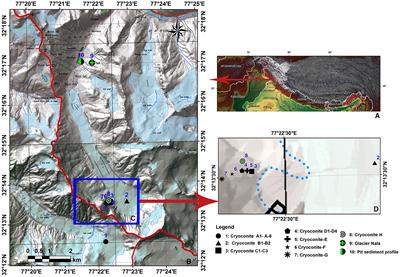Bacterial diversity and biopotentials of Hamtah glacier cryoconites, Himalaya
Cryoconite is a granular structure present on the glaciers and ice sheets found in polar regions including the Himalayas.

It is composed of organic and inorganic matter which absorb solar radiations and reduce ice surface albedo, therefore impacting the melting and retreat of glaciers. Though climate warming has a serious impact on Himalayan glaciers, the biodiversity of sub-glacier ecosystems is poorly understood. Moreover, cryoconite holes are unique habitats for psychrophile biodiversity hotspots in the NW Himalayas, but unfortunately, studies on the microbial diversity of such habitats remain elusive.
Therefore, the current study was designed to explore the bacterial diversity of the Hamtah Glacier Himalaya using both culturable and non-culturable approaches.
The culturable bacterial count ranged from 2.0 × 103 to 8.8 × 105 colony-forming units (CFUs)/g at the different locations of the glacier. A total of 88 bacterial isolates were isolated using the culturable approach. Based on the 16S ribosomal RNA gene (16S rRNA), the identified species belong to seven genera, namely, Cryobacterium, Duganella, Janthinobacterium, Pseudomonas, Peribacillus, Psychrobacter, and Sphingomonas. In the non-culturable approach, high-throughput sequencing of 16S rRNA genes (using MiSeq) showed unique bacterial community profiles and represented 440 genera belonging to 20 phyla, namely, Proteobacteria, Actinobacteria, Firmicutes, Bacteroidetes, Chloroflexi, Acidobacteria, Planctomycetes, Cyanobacteria, Verrucomicrobia, Spirochaetes, Elusimicrobia, Armatimonadetes, Gemmatimonadetes, Deinococcus-Thermus, Nitrospirae, Chlamydiae, Chlorobi, Deferribacteres, Fusobacteria, Lentisphaerae, and others. High relative abundances of Proteobacteria, Actinobacteria, Firmicutes, and Bacteroidetes were observed in the samples. Phototrophic (Cyanobacteria and Chloroflexi) and nitrifier (Nitrospirae) in bacterial populations indicated sustenance of the micro-ecosystem in the oligotrophic glacier environment.
The isolates varied in their phenotypic characteristics, enzyme activities, and antibiotic sensitivity. Furthermore, the fatty acid profiles of bacterial isolates indicate the predominance of branched fatty acids. Iso-, anteiso-, unsaturated and saturated fatty acids together constituted a major proportion of the total fatty acid composition. High cold-adapted enzyme activities such as lipase and cellulase expressed by Cryobacterium arcticum (KY783365) and protease and cellulase activities by Pseudomonas sp. strains (KY783373, KY783377-79, KY783382) provide evidence of the possible applications of these organisms. Additionally, antibiotic tests indicated that most isolates were sensitive to antibiotics. In conclusion, the present study contributed for the first time to bacterial diversity and biopotentials of cryoconites of Hamtah Glacier, Himalayas. Furthermore, the cold-adapted enzymes and polyunsaturated fatty acids (PUFAs) may provide an opportunity for biotechnology in the Himalayas. Inductively coupled plasma mass spectrometry (ICPMS) analyses showed the presence of several elements in cryoconites, providing a clue for the accelerating melting and retreating of the Hamtah glacier.
Read the full article at the original website
References:
